Lesson 1: Set the Context for Appreciative Inquiry
Description
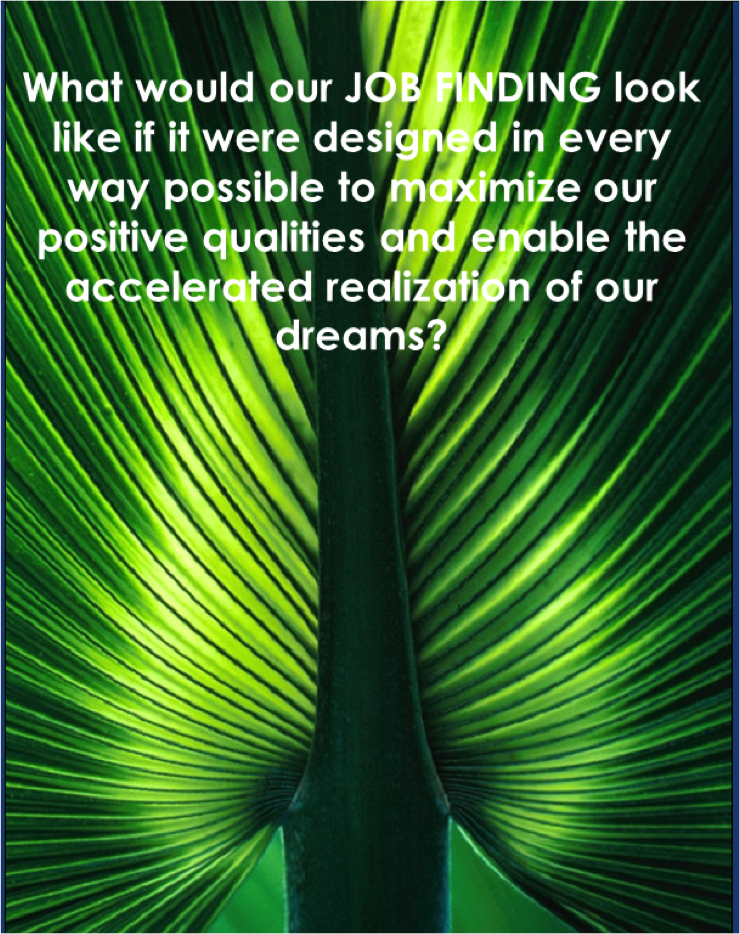
Course Agenda and format
Set the Context for Appreciative Inquiry
Introduction to Appreciative Inquiry
The ‘Art’ of the Positive Question
Application of Appreciative Inquiry

Course Objectives
Demonstrate how Appreciative Inquiry can transform our approach to just about anything including this state of feeling strong while job finding.
Build an understanding of Appreciative Inquiry (AI) principles and how they work in practice.
Build confidence using Appreciative Inquiry (AI) giving participants direct experience with the ‘ways to the state of feeling strong’ for the purposes of resiliency in job finding. Participants will:
Discover core strengths and valued past; the ‘positive core’
Dream and envision the shared future they want to create.
Design a blueprint of the ideal destiny from the discovered positive core aligned with dreams for the future
Deploy a set of actions – value creation initiatives and follow-up learning processes to actively move in the direction of their shared aspirations and commitments.

What You Can Expect From This Course
1. Get a great introduction to the concept and practice of Appreciative Inquiry to add to your toolbox
2. Learn to employ a change process that works.
3. Learn how to come from a positive, “what works” perspective when job hunting.
Outcomes and Opportunities
This session will be a celebration of learning about new ways of looking at the future.
The Six Core Principles of Appreciative Inquiry; Understanding the DNA of Appreciative Inquiry gives us a foundation upon which we can build the infrastructure of a change process that works.
The Eight Assumptions of Appreciative Inquiry; We will define and explore the base assumptions of AI, how they affect the change process and how we may have experienced them already in our individual lives.
The Four Steps to Appreciative Inquiry; From discovering an appreciative question, to dreaming of a future state, to designing a provocative proposal and manifesting a destiny, each step is crucial to the process of Appreciative Inquiry. We get to incorporate the ‘buzzwords’ of the last decade, Innovation, Empowerment, Continuous Leaning, Partnership, and Making A Difference, into a process of change that is FUN! Imagine the possibilities!
Why Appreciative Inquiry [AI]…
When we stay open to possibilities, we don’t know where it will lead!
When we chose to go beyond the traditional landscape, our perspective shifts and leads to infinite possibilities.
Appreciative Inquiry has been described as positive change at the speed of the imagination.
There is a photo with the lighthouse in the distance and a long narrow path reaching out to it.
As job hunters how does this impact us?
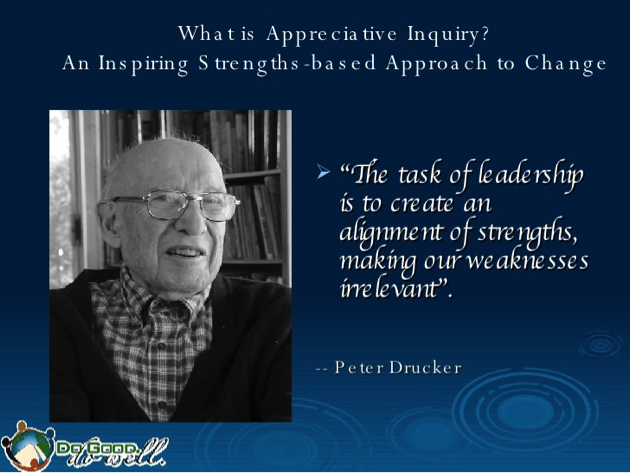
Together we will explore what this means
and you will decide for you how this impacts you. Strengths do more than
perform, they transform.
New way looking at The Future

Consider the future from this old song, “When I was just a little girl, I ask my mother what will I be. Will I be pretty? Will I be rich? Here’s what she said to me. Que Sera Sera. Whatever will be will be, the future not our eyes to see, Que Sera Sera, whatever will be will be?” Song on Youtube.
Peter Eyllard (1998) in Ideas for the New Millennium expressed with an emphasis on the word ‘Can,’ ‘A Possible Future: The Paradigm Shift What Can happen?’ is a combination of the probable and the preferred futures. The blend of the probable and preferred future reflects on the availability of resources, makes value judgments on the relative power and ability of the visionary to shape the future, and the threats and opportunities created by the external environment. Future is part chance and external-driven and part choice and internal-driven. There are different ways of approaching the future.
Probable Future: What will happen? …if carrying on as usual?
Preferred Future: What should happen? What is our dream?
Possible Future: What can happen?
“The best way to predict the future is to create it.” [Eyllard]
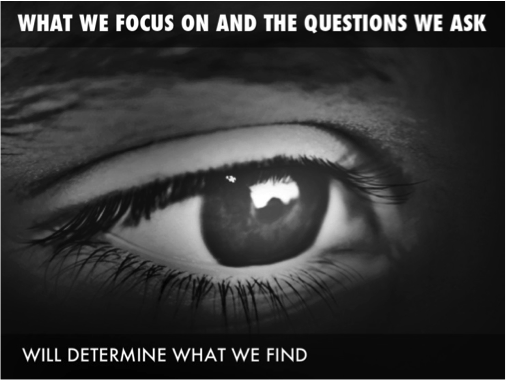
Inquiry and change are
not truly separate moments, instead are simultaneous. Inquiry is intervention.
The questions we ask set the stage for what we ‘find’, and what we ‘discover’
(the data) becomes the linguistic material, the stories, out of which the
future is conceived, conversed about, and constructed. This concept is from ‘A Positive Revolution in Change: Appreciative Inquiry’ David L.
Cooperrider and Diana Whitney, 2003.
What you focus on grows!

AI rests on the premise that ‘the more you focus on what you want the more likely you are to get it.’
The better we understand problems the more likely to give life to them. The more we focus on strengths, assets and aspirations the more likely we are to give life to them!
A good example of what we focus on grows is Applying the Heliotropic Principle to Appreciative Inquiry [AI]. Heliotropism by definition is the growth or movement of a fixed organism, especially a plant, toward or away from sunlight. Heliotropism can be easily seen in sunflowers, which slowly turn their large flowers so that they continually face the sun. Here is a video with no words of a Sunflower field following sun from sunrise to sunset in a 16 second time lapse as each sunflower pinpoints the sun’s progress as it journeys across the sky. You can watch the video online.

Here is an example of a world born out of a created question.
“What it would be like to ride a beam of light?” Albert Einstein


Contrast the Traditional Paradigm with Appreciative Inquiry [AI]
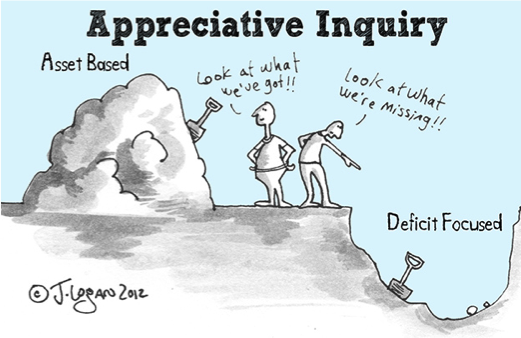
Classic Problem Solving Approach:
‘Felt Needs’ Identification of the Problem, fix what is
Analysis of Root Causes, focus on decay
Brainstorm solutions
Analysis of Possible Solutions
Develop action plans/interventions
When we are asked to do an analysis we start looking for problems. We are programmed to look for problems. Most families, schools, organizations function on an unwritten rule… Let’s fix what’s wrong and let the strengths take care of themselves.
Metaphor: Organizations or an individual is a problem to be solved
“Let’s ensure we completely understand the reasons for our shortcomings!”
Adapted from Cooperrider and Srivasta (1987) "Appreciative Inquiry into Organizational Life" in Pasmore and Woodman (Eds.). Research in Organizational Change and Development. Vol. 1 JAI Press.
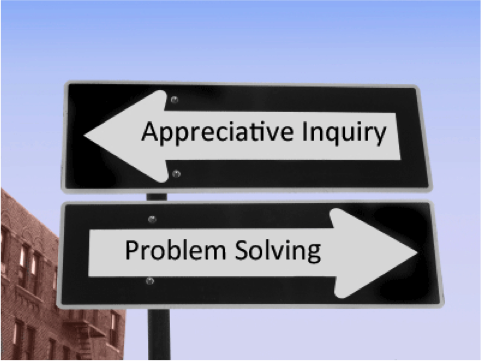
Problem-Solving Implications:
Job hunting/organizations or people can be treated like machines and are Intellect Oriented
Amplify perception of problems
Drain energy
Suppress hopes
Disempowering
Reactive / Flight & Response
Limited Options
Appreciative Inquiry Approach
Focus on Possibilities
Appreciate ‘Valuing the Best of What is’
Amplifying the Positive Core, what is working
Envisioning and Imagine ‘What Might Be’ what is possible
Dialoguing and Determine ‘What Should Be’
Innovating and Create ‘What Will Be’ Design how it can be
Recognize the best of what already exists – strengths
Develop innovations, commit to actions, sustain the effort
Appreciative Inquiry Implications

Organizations and individuals are treated as holistic, living systems
Amplify and build positive aspects of the culture
Create energy and excitement focused on results
Achieve transformation
You move from common ground to higher ground
AI is about life-giving forces in any situation
Visions for the future
Empowering
Proactive
Collaborating Effort
Innovative / New ways / Unlimited Options
Metaphor: The Organization and individual is a mystery to be embraced.
“Let’s understand what makes things work when we are at our best!”When you focus on strengths, weaknesses become irrelevant as Peter Drucker was quoted earlier.
Optional Jackie Kelm from www.appreciativeEngagement.com uploaded on Nov 23, 2011 Description of Appreciative Innovation: An alternative to problem solving 12 minutes YouTube video ‘Appreciative Inquiry vs Problem Solving.mov’. Here is the link: https://www.youtube.com/watch?v=UF2RV_C0XuE
Appreciative Inquiry - Simply Put…

If we continue to search for problems, we will continue to find problems.
Deficit-based, or concentrating on what’s wrong, isn’t a positive or a sustainable method of creating change.

If we look for what is best and learn from it, we can magnify and multiply our success.
AI seeks to build unions between people as they talk about past and present capabilities; focusing on such things as achievements, potentials, innovations, strengths, benchmarks, and memorable stories.
Appreciative inquiry is the ability to recognize the best in people and utilizing those strengths to discover new possibilities and results. Appreciative inquiry focuses on positive thinking and expresses ideas and opinions to reach an end result. What does that mean for you or your job finding? Appreciative inquiry in the workplace or job finding processes encourages students to think positively, which in turn helps them to overcome their own negative thoughts.
Appreciative Inquiry is shifting from ‘What’s Wrong?’ to ‘What’s Right?’

One of the first things that can ruin a positive attitude is looking at a situation and only noticing the negative aspects, or the “What’s Wrong” side. Since the main focus of appreciative inquiry is being positive and aiming towards goals, a pessimistic attitude won’t get anyone very far. When presented with a problem, take a few minutes and look at both sides of the problem. Make a mental list of everything that is positive about the situation before touching on the negative aspects. You’ll find that any situation won’t appear as bad as we think when we notice the positive first.

What is Appreciative Inquiry?
Appreciation + Inquiry = Positive Change

There is a picture of a web after the rain with beautiful water droplet reflections on it.
The Power of Appreciative Inquiry, 2nd Edition, Diana Whitney and Amanda Trosten-Bloom (2003) shared one way to understand Appreciative Inquiry is to consider the meaning of its two words. Each word alone has implications for the practice of organization change. The power of Appreciative Inquiry, however, is the by-product of the two words working together. Like hydrogen and oxygen that combine to make water the most nurturing substance on earth ‘appreciation’ and ‘inquiry’ combined produce a powerful, vital approach to change appreciation-inquiry-positive-change.
Consider the dictionary definitions;
Appreciate
Ap-pre’ci-ate, v., Definition: Recognition and Value Added
Appreciation is about recognition, valuing and gratitude. The word ‘appreciate’ is a verb that carries a double meaning. It refers to both the act of recognition and the act of enhancing value.
- Valuing; To recognize the best in people and the world around us; To value or admire highly; To judge with heighten understanding; To perceive those things which give life, health, vitality and excellence to living human systems; To recognize with gratitude; To affirm past and present strengths, successes, assets and potentials;
- To increase in value, e.g. the economy has appreciated in value. Synonyms include: valuing, prizing, esteeming, and honouring.
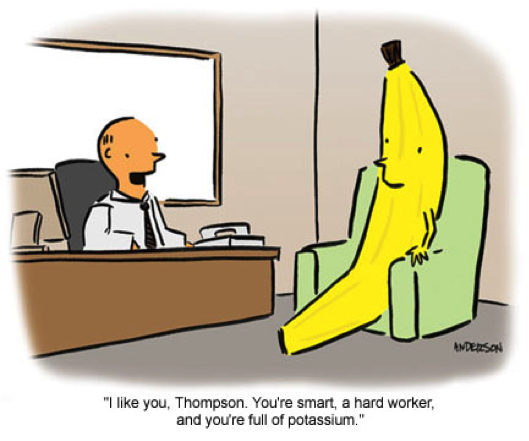
Indeed, individuals, organizations, businesses and communities can benefit by greater appreciation. Around the global, people hunger for recognition. They want to work from their strengths on tasks they find of value. Executives and managers long to lead from their values. They seek ways to integrate their strengths and interests into their daily work. And organizations strive regularly to enhance their value to shareholders, employees and the world at large. Most importantly you seek to incorporate your strengths and abilities in your search for a new job.
Inquire
In-quire’ (kwir), v., Definition: Study, Exploration and Discovery
The spirit of inquiry is the spirit of learning.
- Inquiry refers to the acts of exploration and discovery. To search, explore, delve into or investigate. Synonyms: discovery, search, study and systematic exploration.
- The word ‘inquire’ also a verb means: To seek information by asking questions; It implies openness to new potentials and possibilities, a willingness to learn and to change. It requires curiosity, wonder and being in a state of unknowing. To study;
The act of inquiry requires sincere curiosity and openness to new possibilities, new directions and new understandings. We cannot have all the answers, know what is right, or be certain and truly engage in inquiry.
Appreciative Inquiry [AI]

The four photos are Larva (Caterpillar), Pupa (chrysalis cocoon), cautious first flying moment leaving the stem with potentially still wet wings butterfly, an full-fledged confident flying butterfly.
AI involves the art and practice of asking questions that strengthen your capacity to apprehend, anticipate, and heighten positive potential.
It is the cooperative search, study , exploration for the best in people, their organizations, and the relevant world around them.
AI is rooted in radical social constructionism, appreciation, and the generative power of positive imagery, concentrating on positive means and methods rather than deficit-based, curative action.
AI assumes that every living being and system has untapped, rich, inspiring accounts of the positive. Link this ‘positive change core’ directly to any leadership strategy or change agenda, and changes never thought possible are suddenly and democratically mobilized.
This approach to personal change and organization change is based on the assumption that questions and dialogue about successes, values, hopes, and dreams are themselves transformational.
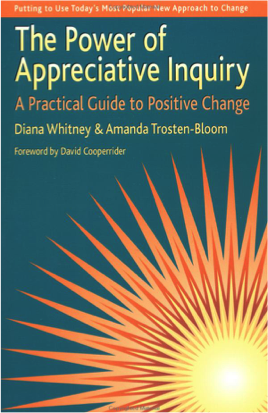
Appreciative Inquiry is a philosophy and a methodology for positive change. It is founded on the simple assumption that human systems – teams, organizations and people – move in the direction of what they study, what they focus upon and what they talk about with regularity.
The essence of Appreciative Inquiry is then the study of what ‘gives life,’ energy and vitality to organizations, teams and people when they are at their best. Appreciative Inquiry does not assume that any person or organization is always at its best. It does posit, and both research and experience show, that people learn, and organizations change most readily when they focus on, study, and engage in dialogue about strengths, patterns of success and who they are at their best.
For this reason, the Appreciative Inquiry process engages large numbers of people in dialogue and deliberations about their individual and collective strengths, their hopes and dreams for the future, as well as opportunities and plans for collaborative action.
The process generally follows the Appreciative Inquiry 4-D Process: Discovery, Dream, Design and Destiny that we will discuss further shortly.
Resource:
http://positivechange.org/how-we-work/appreciative-inquiry-ai
Eight Originating Principles

AI’s Origins are from research from the Weatherhead School of Management at Case Western Reserve University. David Cooperrider is Professor and Chairman of the Case Center for Business as an Agent of World Benefit. It all started with his study at the Cleveland Clinic. There are Eight Core Principles of Appreciative Inquiry; Understanding the DNA of Appreciative Inquiry gives us a foundation upon which we can build the infrastructure of a change process that works.
Eight Principles of Appreciative Inquiry (AI)
Constructionist Principle;
We construct our reality in relation with others; Words create worlds; meaning is socially created, through language & conversations.

Principle of Simultaneity;
Inquiry creates change; the power of the first question; the moment we ask a question, we begin to create change.
Poetic Principle;
There are multiple interpretations; We can choose what we study; organizations, like open books, are endless sources of information and learning.
Anticipatory Principle;
Image inspires action; Human systems move in the direction of their images; what we choose to study makes a difference.
Positive Principle;
Positive affect leads to positive action; Positive questions lead to positive change.
Wholeness Principle;
We cannot do it alone. Wholeness brings out the best in people and organizations; bringing all stakeholders together in a group forum that stimulates creativity and builds collective capacity.
Enactment Principle;
To really make change, we must “be the change we want to see.”
Free Choice Principle;
People perform better and are more committed when they have the freedom to choose how and what they want to contribute.
Conclusion
Albert Einstein quote,
“No problem can be solved from the same level of consciousness that created it. We must learn to see the world anew.”
“There are only two ways to live your life. One is as though nothing is a miracle. The other is as though everything is a miracle.”
In conclusion, why AI?

It’s fun and energising.
It builds on what is working.
It’s healthy!
It adds ownership and confidence, as opposed to strengthening stigma and hopelessness.
It respects where people are and what they know.
It draws on collective wisdom.
(and works against collective dumbness)
It seems to work!
Reflect to yourself …What stood out for you today?
What might be the most useful part that you could use in your practice/ research/ job hunting?
What questions might you want to ponder further as a result of today?
Finito!

Task
Pinword sallows you to create attractive illustrated quotes and lets you grab images off the web to use. Quozio is a similar site. And you can find others at, The Best Tools For Creating Visually Attractive Quotations For Online Sharing.
Phrase.it lets you easily add speech bubbles with your text to photos. You can upload your own, or choose a random image from the site. You’re then given a link to your creation.
Bounce lets you virtually annotate webpages. Just type in the url address, make notes on it (perhaps students can demonstrate their use of reading strategies like making a connection or asking questions) and then post the link on a student/teacher blog or website.
Picture Book Maker, you can easily create a…picture book (including text). It can be saved online or printed out. It’s super-easy to use, plus no registration is required. The url of your creation can be posted on a student/teacher blog or website.
Five Card Flickr Story lets you pick five photos from a group of pre-selected images from Flickr and then write a story about them. It saves your selection and story, and provides you with a link to it. No registration is required.
Continue to Lesson 2: Introduction to Appreciative Inquiry »
Submissions (1)
-
Tania Rashid Discussion post: 3588.1 days ago
